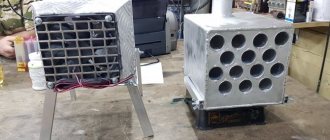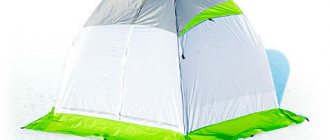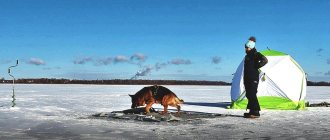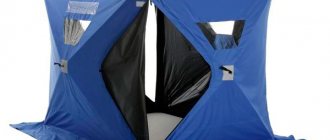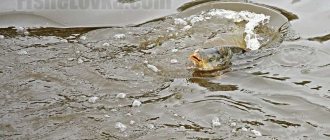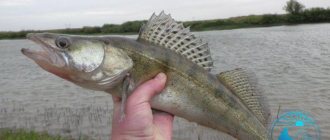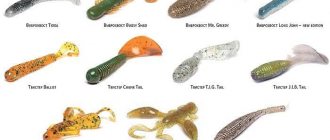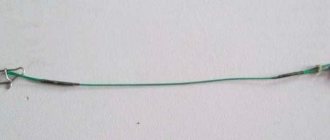Camping with a tent is always an adventure. And it doesn’t matter what time of year it is: winter is not a hindrance for true lovers of forest tourism. Experienced travelers know how to stay warm in a tent: they stock up on insulated sleeping bags, double-layer tents and warming tea (read more about how to choose a sleeping bag). Choosing a parking spot away from the wind is half the battle. It is necessary to ensure that the tent is warm and comfortable at night. Nowadays, there are many ways to heat a tent. Let's take a closer look.
Heating a tent while fishing
The first thing you need to do is decide on the volume of the room that will need to be heated. A tent for one or several people presents challenges for different types of heaters. On the topic of how to heat a tent during winter fishing, there are many videos and opinions of experienced fishermen. We will try to put together basic information on this issue.
Way to heat a tent
Gas canister-based stoves and burners
The first thing that attracts winter fishermen to this method of heating a tent is the affordability of such cans. But as soon as the temperature drops below - 10 degrees , the can will freeze and will need to be heated.
The burners heat a winter fishing tent well, but the risk of fire is extremely high due to possible gas emissions and fire. And it’s worth transporting it separately from other things so that no debris gets inside the burner. Otherwise, nothing good will come of the heating: it will either not light up at all, or it will burst into flames.
Spray canned tiles are best in the summer, perhaps in the fall. A tile packed in a black suitcase is especially convenient: you can warm up something, for example, tea or coffee.
Liquid fuel stoves, alcohol stoves, burners
What's bad: you need to carry a canister of fuel with you. Moreover, the canister must be of high quality to avoid leakage. Plus, if there is direct contact with your hands, the smell of gasoline or kerosene is extremely difficult to get rid of. What’s good about it is that it heats beautifully and you can cook anything.
You can use kerosene lantern heaters. Single tents are extremely warm and provide excellent illumination of the hole. But the minus is still the same - fuel.
Why is heating so important?
Low air temperatures during winter fishing are quite problematic to deal with. If you plan to spend 1-2 hours fishing at most, and the air temperature is not lower than -10 degrees Celsius, you can get by with a special winter fishing suit with fleece, insulated gloves and thermal underwear. If the temperature drops below 20 degrees Celsius, the astronauts' suit will not be able to protect them from the cold, so it is important to think about an additional heating method.
Without a tent with a heater, it’s quite easy to freeze on an open body of water in a matter of minutes. Remember that prolonged exposure to the cold will in any case result in negative consequences for your health, even if they do not appear immediately.
How to warm a tent with a candle
This method is more suitable for autumn than for winter cold. Let us first note the danger of heating a tent with a candle: it is still an open fire. However, if you have insomnia and can watch the flame all night, then this is just your option. You can also place the candle in a safe burner. At one time, tourists came up with a method using an old flask thermos. The candle is placed in it, and when it falls, it remains there. And heating the walls of the thermos with it increases heat transfer.
We recommend reading:
How to light a fire without matches
Heating a tent with candles
About heating a tent with candles
Despite the fact that now there are many different burners, stoves and heaters, there are still fishermen who heat their winter tent with paraffin candles.
Behind all the seeming frivolity of this approach lies a very good potential, because the calorific value [1] Another name is the specific heat of combustion, is determined per 1 kilogram of substance per hour of combustion. paraffin is comparable to the same indicator for other petroleum products. It is 48 megajoules , which is even slightly more than gasoline (44 mJ). To put it in more or less everyday language, leaving behind the scenes tedious physical calculations, it turns out that a kilogram of paraffin, burning for an hour, will produce the same amount of heat as a 13-kilowatt semi-industrial thermal gun.
Now let's calculate the same for one paraffin candle. For example, let’s take “IKEA” (these are puck-shaped candles in aluminum foil cups).
The mass of such a candle is approximately 12 grams. This amount of paraffin will be 83 times “weaker” than a kilogram of this substance - 157 watts versus 13 kilowatts. But, again, we determined this “thermal power” taking into account the fact that the paraffin will be completely consumed in an hour. And the burning time of one candle (according to the manufacturer) is 4 hours [2] There are similar candles - twice as large in volume and burning for 9 hours.. After basic calculations, it becomes obvious that the output power of one “ Ikea” candle is 39 watts .
The smallest gas stove on disposable cylinders has a power of no more than 2 kilowatts, and this is more than enough to heat a tent. Hence the conclusion - to compete with this power, we will need no more or less - 50 candles .
Of course, this figure is for good frost outside the wall of the tent - about 25 degrees. It is with it that you begin to drive the tiles for a long time at full power. In warmer weather, you may need half as many candles. Or even three times, especially if our goal is not so much to heat the tent, but to maintain the holes in a non-freezing condition.
But still, let’s consider the option with 50 candles - as the most costly. When placed compactly, all candles will occupy an area of approximately 40 by 20 centimeters - the same as an average-sized tile. You will have to tinker a little with igniting the “candle battery”.
For 8 hours of fishing you will need 100 candles (this is approximately 1.2 kilograms of paraffin).
When converted to rubles, even more interesting figures emerge, especially if you compare paraffin with the same gas. If you use a burner, for 8 hours of fishing you will need 2 half-liter cylinders costing 80 rubles each - that’s 160 rubles for the entire fishing trip. A package of 48 candles costs 130 rubles, two packages - 260 [3] About the same - 250 - costs a package of 24 “large” candles, burning for 9 hours, therefore they will cost 500 rubles, which is even less profitable. It turns out that we will save 100 rubles on gas. However, candles have an undeniable advantage over “blue fuel” - they do not freeze in the cold and can be lit at any temperature. And of course, they don’t require any additional equipment.
It turns out that purified technical paraffin of grade P-2 at wholesale prices costs quite tolerably - 40-50 rubles per kilogram [4] And unrefined grade NS paraffin is even less - about 30 rubles / kg.. And if there was a refillable burner that runs on paraffin — the potential of this fuel could be fully revealed. Then paraffin would become a good alternative to gas and gasoline.
But this is a topic for a separate conversation, beyond the scope of this article.
Notes[]
Notes
| ↑1 | Another name is the specific heat of combustion, determined per 1 kilogram of substance per hour of combustion. |
| ↑2 | There are similar candles - twice as large in volume and burning for 9 hours. |
| ↑3 | A package of 24 “large” candles, burning for 9 hours, costs approximately the same - 250, therefore they will cost 500 rubles, which is even less profitable |
| ↑4 | And the unrefined NS brand is even less - about 30 rubles / kg. |
Heating a tent with stones
The old way. Designed for extreme cold. But in order to preserve the heat of the stone for a long time, it will be necessary to carry out a number of simple manipulations. The first option is to put it in a container (kettle or pan with thick walls) and cover it with a lid. The heat will dissipate more slowly. The second option is to wrap the stone in foil, preferably in several layers. This way the stone will remain warm for 6-8 hours. If you feel that the temperature has decreased, it is tedious to remove one layer of foil.
Stones in the tent
An old-fashioned way to warm a tent
People with imagination, of course, can come up with many devices from scrap materials in order to heat a tent. Alternatively, use a kerosene lamp and a piece of tin.
- The tin square is rolled into a cylinder approximately 40 cm and soldered. The diameter should match the diameter of the top of the kerosene lamp.
- Next, six circles are cut out from the same material and with the same diameter. It is better to place small “petals” along the edges so that it is convenient to solder them to the cylinder.
- Several holes are made in each circle. They are made closer to the edge of the circle and not over the entire area, but only in one place. You should get a cluster of 6-8 holes.
- These circles are located inside the cylinder at an equal distance from each other so that the holes are not on the same line, but alternate in location. That is, the air will rise through them not in a straight line, but in a wave-like manner.
- The top of the cylinder is closed with a lid with a small piece (approximately 10 cm) of metal hose inserted into it. Warm air will eventually come out of it.
- This entire structure is mounted on top of a kerosene lamp. The heat will rise to the top , spreading throughout the tent. This way you can heat your tent while fishing in winter; there is a detailed video instruction on this.
We recommend reading:
Sights of Venice
How to make heating in a tent for winter fishing with your own hands
The easiest way is to make an alcohol lamp for heating, but this option is not suitable for many.
We recommend reading about how to make a winter fishing rod with your own hands.
For real heating, it would be better to create a stove using:
- Cans from cans are 10 cm in diameter and 6 cm in height.
- A steel mug is 1 cm smaller than the cans.
- Tough.
- Bolts, washers.
- TV antenna.
- Terminal.
Creating a stove is done as follows:
- All sharp edges and irregularities on the cans are removed. To do this, you can use pliers or another tool.
- A 3 cm circle is cut out of a tin bush, on which 3 petals are made with a 90 degree bend.
- Drill large holes at the bottom of one jar so that the petals fit into them. The circle itself is installed under the bottom of the jar.
- Combustion material will be placed in the free space between the elements.
- Stepping back 2 cm from above, make 3 holes with an equal distance from each other with a diameter of 5 mm.
- Bolts and washers are inserted into the prepared places, on which the mug is placed.
- The antenna is needed to cut out 3 legs, for which new holes are made.
- The second jar will be needed for the lid. It will fit tightly to the top, which helps improve thermal output.
- The terminal is used for the handle and can be placed in the center of the cover.
- At the bottom of the oven, 5 holes are additionally drilled at equal distances.
The best way to heat a tent - reviews
Oksana, 39 years old. “My husband and I are mountain climbers. And mainly in winter. The air there at this time is such that you can’t breathe. And how many health benefits! At one time, a dog was eaten on tourist equipment. We often go away for more than one day, we can spend a night in the mountains, or even more than one. When heating the tent we use stones. We’re already used to it: it retains heat for a long time, you can always find them in the mountains, even in winter. And it doesn’t require much physical effort. Wrap it in foil.”
Ruslan, 27 years old. “We love evenings around the fire with friends. Guitar, songs - romance! Just as our parents vacationed with us, we passed on the habit of spending weekends in the forest. We usually warm the tent with a fire. There is nothing complicated about it, and the heat lasts a long time, almost all night. You can even walk around the tent barefoot.”
Alexander. 32 years. “We became interested in hiking quite recently. Before going on our first hike, we studied a lot of materials about what is best to buy, how to make a fire, where to put up a tent, etc. Not everything worked out right away and well. But we decided not to give up. And literally the third time we spent a completely comfortable and warm night in the fresh air. How did you warm yourself at night? Yes, very simple. We filled the canisters with hot water. One canister was left at the exit of the tent, the other was placed at the head of our sleeping places. And two smaller canisters were placed in sleeping bags. The result was some kind of hot water bottles. It was enough for almost the whole night, at least those that we put in our sleeping bags. Those that were simply left in the tent eventually cooled down. We do not plan to stop with this method; we will try others. But we’ll definitely remember this one.”
Maxim, 35 years old. “We use kerosene stoves. This is much simpler and more reliable! The smell, however, is difficult to remove, but you can warm up and heat food on it. In winter, a completely irreplaceable thing! And it’s not bulky, it doesn’t take up much space. Now, by the way, they are sold on the Internet with all sorts of bells and whistles and improvements. We are planning to purchase”
Author of the publication
offline 3 years
Nika
10
I am interested in hiking and traveling, photography and videography. I have been going hiking since childhood. The whole family went and went - sometimes to the sea, then to the river, to the lake, to the forest. There was a time when we spent a whole month in the forest. We lived in tents and cooked over fires. This is probably why I am still drawn to the forest and, in general, to nature. I travel regularly. About three trips a year for 10-15 days and many 2 and 3 day hikes.
Comments: 0Publications: 668Registration: 10/23/2018
Nika Survival in the wild, Fire, heat, Articles
Handy tools and homemade products
For autumn, the old method of how to warm a tent while camping with a candle is suitable. It is installed in the burner; you can use a reflector to concentrate heat in a specific place. The advantages of the method are simplicity and cost. Disadvantage - not suitable for winter, fishing, you need to monitor the state of the flame. Since it is difficult to heat a tent while camping this way, you need to explore other options. They are chosen during preparation for an independent trip.
Therefore, they use other methods of heating the tent. You can heat large quality stones in a fire and place them on a heat-resistant tray. They will give off heat for a long time, but they take up space and there is a chance of damaging equipment. Volume heating time – 5-10 minutes. But it will cool just as quickly if the dome is not sealed. When traveling independently, it is difficult to fulfill the last condition.
The optimal method is to install a homemade stove that runs on solid fuel. It can be used as a camp kitchen for heating or preparing food. But how to heat a tent if there is smoke from fuel in it? To do this, make a chimney pipe that exits through the ventilation hole.
